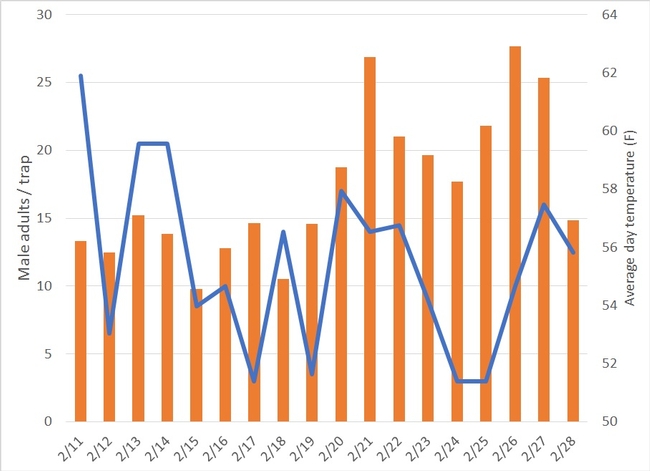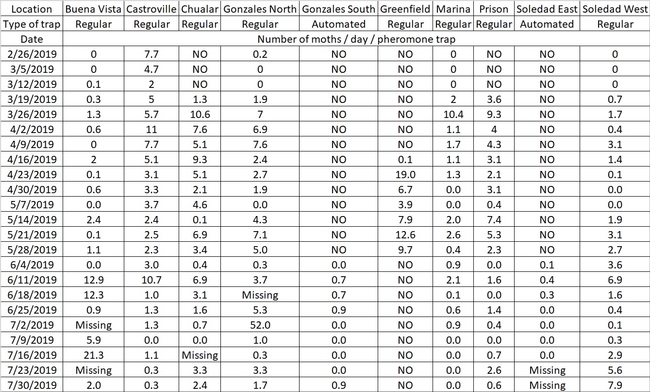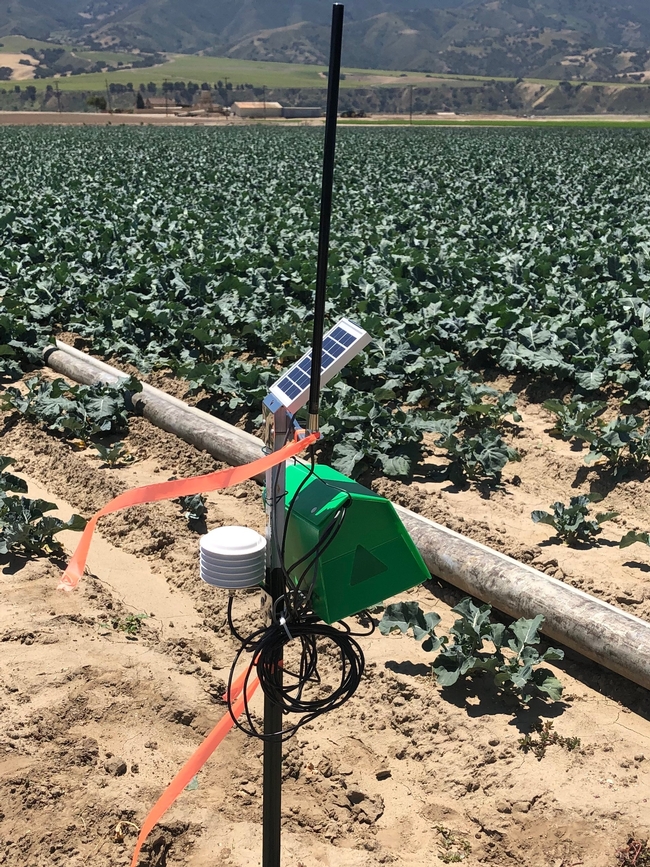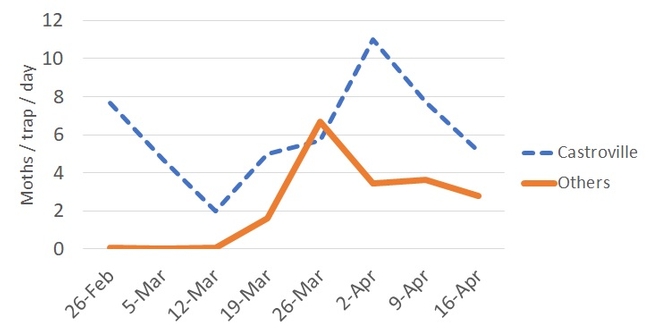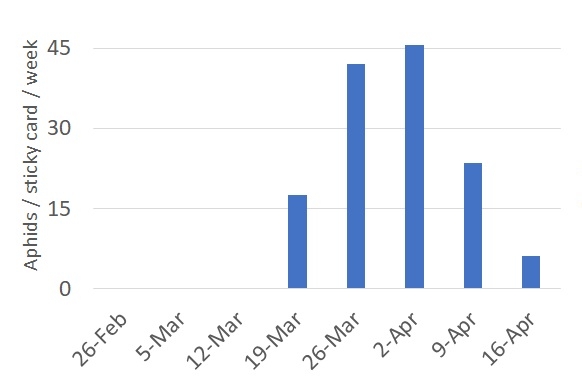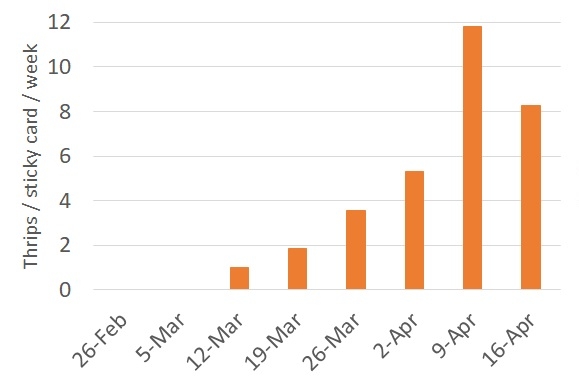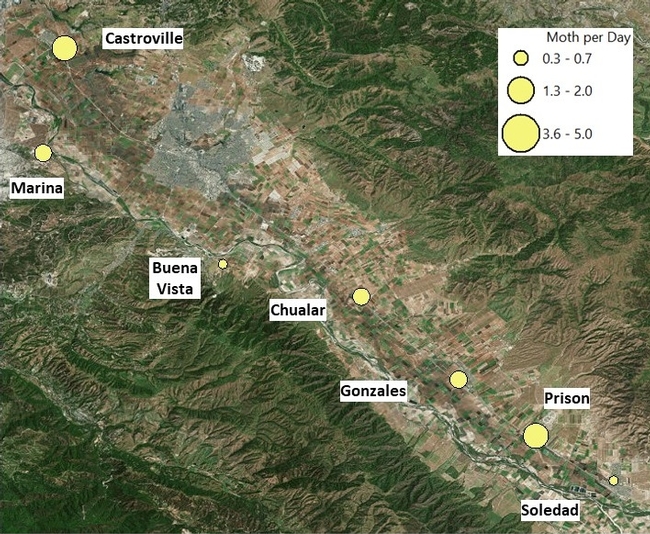- Author: Alejandro Del Pozo-Valdivia
Diamondback moth adults have been actively flying across the Salinas Valley these winter months, based on our area-wide monitoring program. There were a couple of locations where we recorded 'zero' captures during January. It looks like low temperatures in the Valley just slowed down this moth development. At this point, it will be difficult to propose that there was an overwintering generation this past winter. Specially in the Castroville area, where there has never been a 'zero' capture from our two traps. Having an overwintering generation would have represented 'zero' captures from all or most of our pheromone traps across the Valley.
We continue the effort to validate automated pheromone traps. In partnership with AgCeleration and TrapView, we are testing in the field a new prototype (Fig. 1). So far, there is no significant difference on the weekly captures between this new automated trap when compared to a typical cardboard pheromone trap. These automated traps provide real-time information on the number of diamondback moth males captured in a daily based. This type of information could ultimately help to understand the trends of the adults moving across the farmscape, strengthening an IPM program in cole crops.
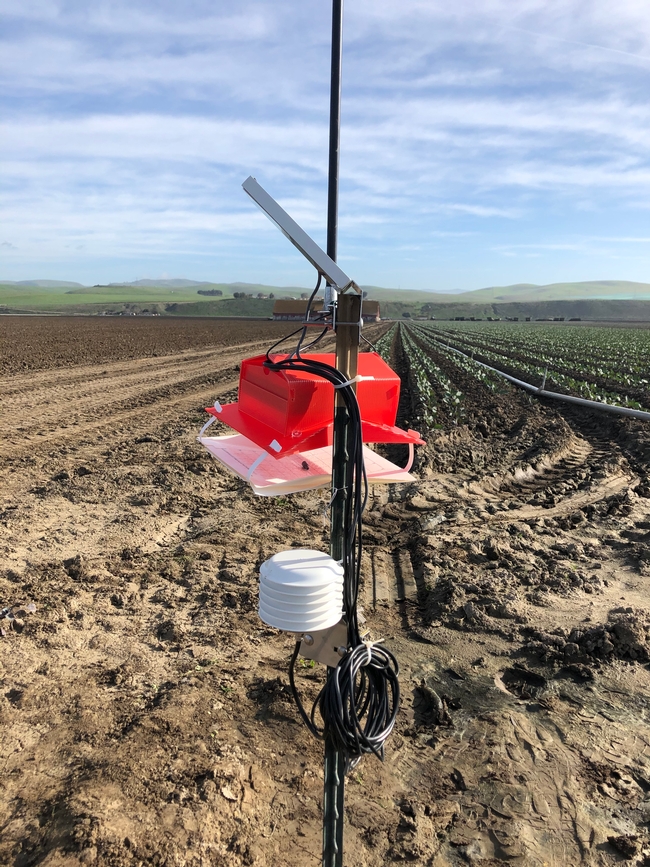
Daily captures of diamondback moth male adults indicate that the highest populations are currently located in the Castroville area. On average, we have captured 12 males per day since February 11th (Fig. 2.). Most of the fluctuation on number of captured adults might have been mediated by air temperatures. The current trend shows that adult captures are going down. It is likely that large populations of this pest were able to go through a generation in the Castroville area using crop, weed host plants, and crop residues. It is important to recognize that:
1) Castroville area continues to be a hot spot with the largest diamondback moth population across the Salinas Valley.
2) Promptly scouting of blocks with cole crops will help to early detect the presence of economically relevant numbers of caterpillars.
3) Manage weeds, specially at the surrounding areas of established blocks, will reduce the overall population.
4) Promptly elimination of cole crop residues from previous plantings will reduce the overall population.
5) Rotate the use of insecticides will reduce the possibility to develop insecticide resistance.
6) Use of adjuvants/stickers will reduce the possibility of washing away any insecticide spray onto waxy cole crop leaves.
If you would like to learn more about the current status of diamondback moth in the Salinas Valley, please contact Alejandro Del-Pozo at adelpozo@ucanr.edu or call 831-759-7359.
- Author: Alejandro Del Pozo-Valdivia
Last year, this pest was present in large numbers during August and September. The idea is to have additional data from the pheromone traps to inform the IPM decision making process. Below is a table showing the number of moths per day and per trap since February.
Table 1. Male diamondback moth captures by pheromone traps across the Salinas Valley. There are two type of traps deployed in the fields. We have the cardboard traps labeled as 'Regular' and also the automated traps labeled as 'Automated' and shown in Fig. 1.
Fig. 1. Automated trap (provided by AgCeleration and manufactured by TrapView) in a broccoli field. This type of trap has four cameras on top of the sticky liner. Cameras will take daily pictures. Pictures are analyzed to recognize the adult of diamondback moth. This trap uses a cellular connection to transmit the pictures daily to a centralized computer. The computer will use machine learning to recognize and count new moths getting stuck onto the liner.
To put these captures on a time perspective, the below time series graph shows the fluctuation of the diamondback moth captures since we set up the traps. The below graph does not include the data from the automated traps. Capture data is broken into a series labeled 'Castroville' (dotted line) indicating the moth captures from that specific location, and a second series labeled 'Other' (solid line) where the average captures among the other locations are presented.
If you are interested in learning more about this monitoring program, please contact Alejandro Del-Pozo at adelpozo@ucanr.edu or 831-759-7359.
- Author: Alejandro Del Pozo-Valdivia
We are happy to announce that the diamondback moth capture data, presented as maps, is now housed in our own University of California Cooperative Extension Monterey website.
To access to these maps, simply click on the link below:
http://cemonterey.ucanr.edu/Agriculture/2019_Diamondback_moth_monitoring_maps/
These maps use the closest town or landmark where the traps are located to show moths per trap per day. Moth captures are presented as yellow bubbles. The bigger the bubble, the larger the population of moths is.
On the same page, you will also find the overall population fluctuations of these moths in the Valley, as a series chart.
We also stored the overall fluctuation of aphids and thrips numbers, captured in yellow sticky cards in our UCCE Monterey website. To access to these bar charts, click on the link below:
http://cemonterey.ucanr.edu/Agriculture/2019_Aphid_and_Thrips_Monitoring_Program/
If you would like to learn more about these three monitoring programs happening in the Salinas Valley, do not hesitate to contact Alejandro Del-Pozo at adelpozo@ucanr.edu or 831-759-7359.
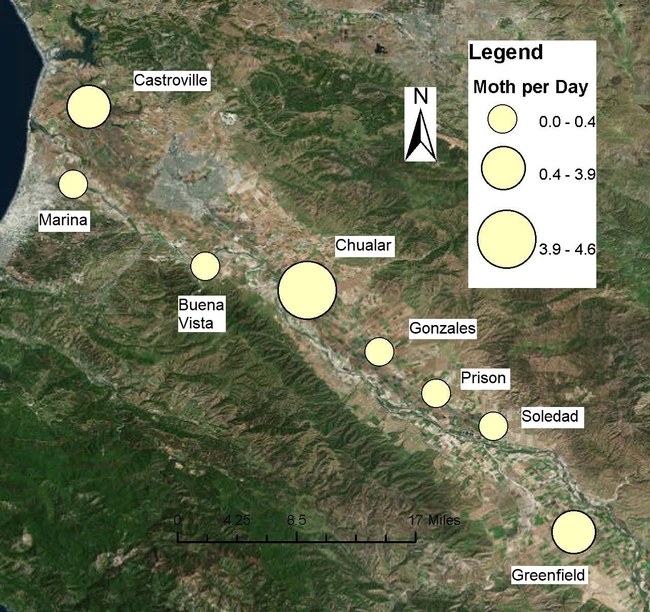
- Author: Alejandro Del Pozo-Valdivia
We continue the effort of monitoring diamondback moth (DBM) across the Salinas Valley using sex pheromone baited traps, as shown in the picture above. We have been adding additional traps to cover a larger area along Highway 101. We have daily moth capture data from Castroville to Greenfield. The chart below summarizes these daily captures from our pheromone traps.
As stated in a previous blog post, higher numbers of DBM have been usually recorded in Castroville. It seems like we just passed a generation of adults during late March to early April. Currently, DBM capture numbers are going down. Lower adults in the system could be paired with more caterpillars feeding on several host plants.
We have set up yellow sticky cards to track the overall population of winged aphids and thrips. These sticky cards are in the same locations as the pheromone traps. At this point, data for aphids and thrips is not broken down at the species level.
From the chart above, there was a flight of aphids during late March to early April. Some PCAs mentioned to me that foxglove aphid started to show up in their fields during that time period. It seems now that winged aphid numbers are going down. However, it does not mean that numbers of aphids in our crops are decreasing. We might be facing higher population of wingless aphids in our crops right now.
We need to keep an eye on population dynamics of thrips in the Valley. The ultimate goal is to be better prepared this season to manage those creatures and reduce the incidence of INSV virus. The chart below shows captures of thrips in our sticky cards.
It seems like thrips populations had a spike two weeks ago. Currently, thrips numbers are going down. I believe that keeping track of the fluctuation of thrips numbers in our Valley would help us detect large populations of this pest. There is a need to alert PCAs when the front of a 'thrips wave' would happen.
If you are interested in getting more information on this monitoring effort, please do not hesitate in contacting Alejandro Del-Pozo at 831-759-7359 or adelpozo@ucanr.edu.
- Author: Alejandro Del Pozo-Valdivia
There are sex pheromone traps for Diamondback moth set up across the Salinas Valley. This pheromone only attracts males of this pest. These traps were first put out on February 20th, 2019. Traps are located in Castroville, Marina, Buena Vista, Chualar, Gonzales, by the Prison (near Soledad), and Soledad. Thanks to the PCAs who are helping me with this project.
Basically, numbers of moths per day per trap have been zeros, with the exception of the trap located in Castroville. Interestingly, moths were captured in all traps last week. The actual values of those captures are presented in the below figure as yellow dots. The bigger the dot represents a larger moth capture.
It seems like a new flight for the diamondback moth is about to begin across the Salinas Valley. Additionally, there has not been a break on the life cycle of this pest in the Castroville area. Population of this moth are persistent throughout the year in that area. The trap in Castroville has always captured moths since it was set up. Populations of this moth are residents of brassica weeds, as noted in previous scouting trips.
But, what does it mean to have less than one moth per trap per day, compared to 5 moths per trap per day? Is 5 moths a high value? How is that translated to caterpillars in the field? The next step will be to pair moth trap captures with actual scout data for caterpillars found in the surrounding areas of the traps. In the meantime, the information from these traps could help us to potentially predict when caterpillars might be present in the system in larger numbers. It is more likely that we will be able to see an increase of diamondback moth caterpillars in the next two weeks. It may be good to pay attention to cole crop fields, with the goal to early detect potential damaging populations of this pest in scouted fields.
I will be updating this map with moth captures at least every other week. Stay tune!
If you would like to learn more about this project, do not hesitate in contacting Alejandro Del-Pozo at adelpozo@ucanr.edu or 831-759-7359.

